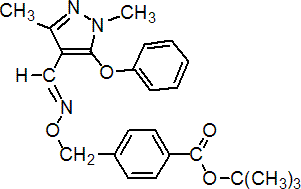|
fenpyroximate
Acaricide
IRAC 21; METI

NOMENCLATURE
Common name fenpyroximate (BSI, draft E-ISO)
IUPAC name tert-butyl (E)-a-(1,3-dimethyl-5-phenoxypyrazol-4-ylmethyleneamino-oxy)-p-toluate
Chemical Abstracts name 1,1-dimethylethyl (E)-4-[[[[(1,3-dimethyl-5-phenoxy-1H-pyrazol-4-yl)methylene]amino]oxy]methyl]benzoate
CAS RN [134098-61-6]; [111812-58-9] unspecified stereochemistry Development codes NNI-850 (Nihon Nohyaku)
PHYSICAL CHEMISTRY
Composition Tech. is 97.0%. Mol. wt. 421.5 M.f. C24H27N3O4 Form White, crystalline powder. M.p. 101.1-102.4 ºC V.p. 0.0075 mPa (25 ºC) KOW logP = 5.01 (20 ºC) S.g./density 1.25 g/cm3 (20 °C) Solubility In water 1.46 ´ 10-2 mg/l (20 ºC). In methanol 15, acetone 150, dichloromethane 1307, chloroform 1197, tetrahydrofuran 737 (all in g/l, 25 ºC). Stability Stable in acid and alkali.
COMMERCIALISATION
History Acaricide reported by T. Konno et al. (Proc. 1990 Br. Crop Prot. Conf. - Pests Dis., 1, 71). Introduced in 1991 by Nihon Nohyaku Co., Ltd. Manufacturers Nihon Nohyaku
APPLICATIONS
Biochemistry Inhibitor of mitochondrial electron transport at complex I. Mode of action Quick knockdown activity against larvae, nymphs and adults, mainly by contact and ingestion. Also some moulting inhibitory activity on nymphs. Uses Control of important phytophagous mites. Effective against Tetranychidae (spider mites), Tarsonemidae, Tenuipalpidae (false spider mites) and Eriophyidae in citrus, apple, pear, peach, grapes, etc., at 25-75 g/ha. Phytotoxicity Not phytotoxic to top fruit, citrus, tea, vegetables and ornamentals. Formulation types SC. Compatibility Incompatible with calcium polysulfide. Selected products: 'Danitoron' (Japan) (Nihon Nohyaku); 'Danitron' (Nihon Nohyaku); 'Ortus' (Nihon Nohyaku); 'Pamanrin' (China) (Nihon Nohyaku)
OTHER PRODUCTS
'Akari' (Nihon Nohyaku, Sepro); 'Kiron' (Nihon Nohyaku); 'Manhao' (Taiwan) (Nihon Nohyaku); 'Meteor' (Nihon Nohyaku); 'Acaban' (Syngenta); 'Acaritan' (Bayer CropScience); 'Asalto' (Syngenta); 'Dynamite' (Syngenta); 'Kendo' (Bayer CropScience); 'Miro' (Bayer CropScience); 'Naja' (Syngenta); 'Sequel' (Bayer CropScience); 'Terror' (Calliope) mixtures: 'Superman' (+ propargite) (China) (Nihon Nohyaku)
ANALYSIS
Product analysis by hplc; residues in soil by glc, in water by hplc, in plants by glc/hplc.
MAMMALIAN TOXICOLOGY
Reviews FAO/WHO 74, 76 (see part 2 of the Bibliography). See also J. Pestic. Sci., 17, S261-267 (1992). Oral Acute oral LD50 for male rats 480, female rats 245 mg/kg. Skin and eye Acute percutaneous LD50 for male and female rats >2000 mg/kg. Non-irritating to skin; slightly irritating to eyes (rabbits). Inhalation LC50 (4 h) for male rats 0.33, female rats 0.36 mg/l. NOEL for male rats 0.97, female rats 1.21 mg/kg b.w. ADI (JMPR) 0.01 mg/kg b.w. [1995]. Other Not carcinogenic, teratogenic or mutagenic in long-term studies. Toxicity class WHO (a.i.) II (company classification)
ECOTOXICOLOGY
Birds LD50 for bobwhite quail and mallard ducks >2000 mg tech./kg. Dietary LD50 (8 d) for bobwhite quail and mallard ducks >5000 ppm. Fish LC50 (48 h) for carp 0.006 mg/l. Daphnia LC50 (3 h) 0.085 mg/l. Bees No adverse effect on honeybees at 250 ppm (5 ´ recommended dose). Other beneficial spp. Relatively non-toxic to predacious mites. Little adverse effect at 25-50 ppm on Chrysoperla carnea, Harmonia axyridis, Ephedrus japonicus, Misumenops tricuspidatus, Lycosa pseudoannulata, Orius sp., Scolothrips sp.
ENVIRONMENTAL FATE
Soil/Environment DT50 26.3-49.7 d (J. Pestic. Sci., 18, 67-75 (1993)).
|